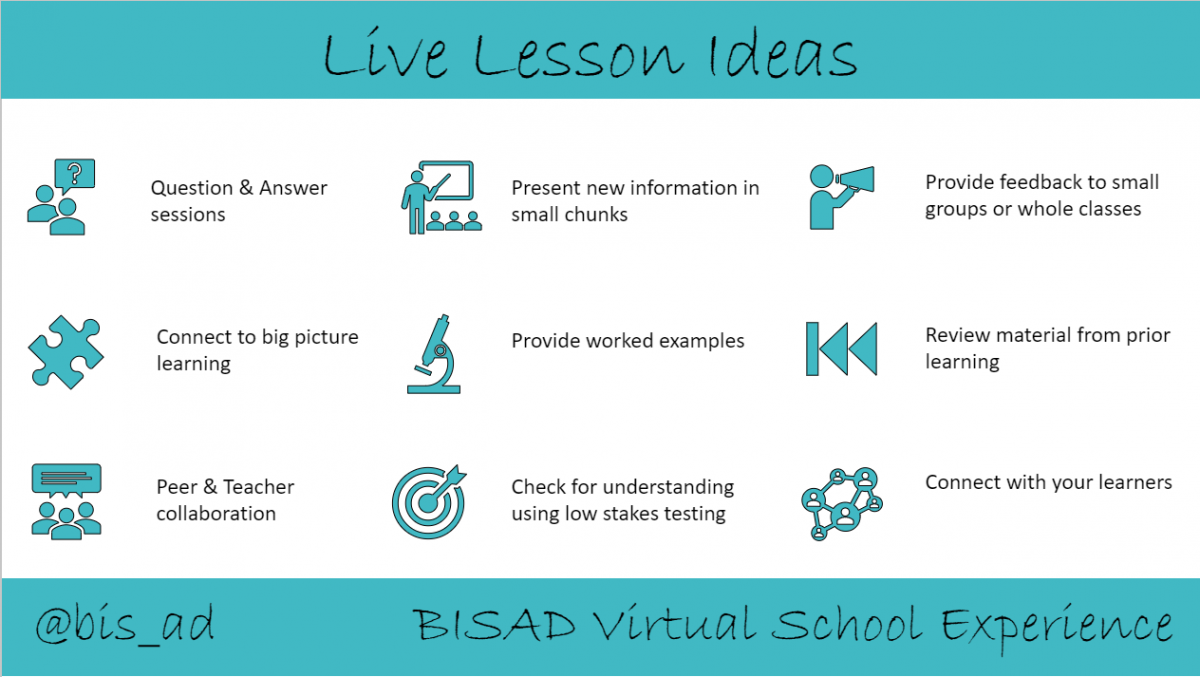Remembering our online learning context

Some of our preconceptions and beliefs have been challenged in recent years thanks to the rise in our understanding of neuroscience and the mechanics of how we learn while improving our practical application of theories to a classroom context along with making evidence-informed decisions around technology to aid learning and teaching. We now also understand fairly well that experts and novices not only think but learn differently when compared to one another, however, everyone has the ability to be both an expert in a particular area or domain whilst also being a novice in another. Such is the beauty of both how our brains work and the vast expanse of the sum of all human knowledge.
In a rather recent and topical social media debate, which can feel akin to an echo chamber at times, has been the ongoing discussion of how we should be facilitating learning with (not for!) our students at a time of online learning; synchronous or asynchronous learning?
Coupled with this, schools seek to communicate more than they ever did with parents as they know the vitally important role they too play within education. As stakeholders, parents are invested in supporting their children, clear plans are communicated by schools while parents and students answer surveys to give schools feedback on the journey so far and how they might go about adapting their offering. The potential problems is that surveys will do two things; provide a soundboard to hold teachers to account and reveal the two ends, quantity vs quality, of the expectation spectrum regarding online learning. Many teachers are learning new skills at an unprecedented rate ready to harness their potential while all leaders of learning are indirectly moderating their output to ensure they systematically improve their new classrooms.
It still rings true, when Lydgate wrote: “You can please some of the people all of the time, you can please all of the people some of the time, but you can’t please all of the people all of the time”. Whatever happens, we must remember that context is indeed still king and we all have to trust one another ensuring we supplement one another, rather than judge, as we are all responsible for online learning; teachers, students and parents.
Whilst we live in challenging times, as professionals, we are leading learning in a new direction that is both a best fit for our school context and one that is equitable for all individuals. Equity can be challenging in itself to define given that its meaning has multiple modes: opportunity, outcomes, resourcing, free from bias, inclusivity and support to name a few strands of equitable education. Coupled with this is the need for flexibility in a time where there are so many unknowns and the routine of school is, compared to our previous paradigm, a shift for all of us and a route to carefully navigate new and innovative ways of working.
This begs the obvious question of whether or not online schooling should be completed live to simulate as close to a real-time experience as possible; enabling human connectivity and dynamism so that learning forges on despite the geographic location differences. Rivalling this is virtual schooling where you work at your own pace and complete a series of preordained and recorded tasks throughout your chosen daily learning hours which can arguably leave the learner feeling more isolated and will likely come to a crossroads in terms of unsustaining motivation if there isn’t clarity on how knowledge builds on knowledge in those curriculum areas.
Whether we like it or not we are back to the debate of synchronous vs asynchronous again. In order to be equitable, flexible, connected and sustainable for teachers and students the truth is we need a mixture of both methodologies. While our contexts are different in schools, we know that students thrive when given the chance to engage in a collaborative process that enables passionate exploration and discussions around new learning. The flip side to this is that not every student wishes to contribute in an online setting, much like the safer confines of a classroom, so providing a varied diet of synchronous and asynchronous lessons for students can only be a positive as it will appeal to all learners, offer a balance between flexibility and rigidity while also focusing on quality over quantity.
It is worth noting that not all live lessons need to be live for the duration of the lesson nor be focused purely on new material, it’s a great opportunity to hold question and answer sessions, provide feedback to smaller groups, complete low-stakes quizzes or simply connect with your learners. I shared the infographic below with staff at BISAD, and here on Twitter, to give a few ideas for live lessons and make the point that live online teaching can and should be sustainable, purposeful and equitable for all stakeholders.

Follow Olly on Twitter or read his blog to get more insight on all things learning, teaching and technology.
Stay up to date
Subscribe to the free GESS Education newsletter and stay updated with the latest insights, trends, and event news every week. Your email address will remain confidential


